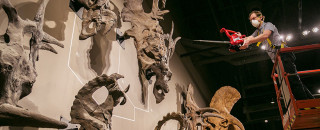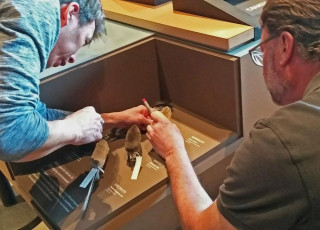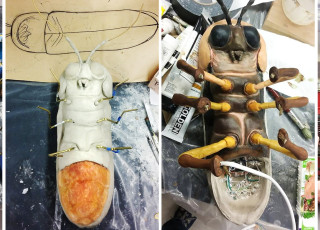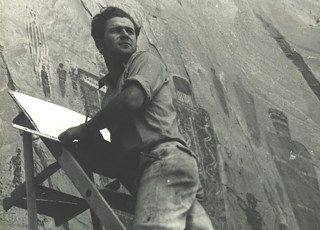Dusting our Dirty Dinosaurs
Geoffrey Leonard blowing dust off of the ceratopsian wall. Photo by Mark Johnson. © NHMU
By Michael Mozdy
Fossils and dust have an immutable bond. Ask the field paleontologist, and she’ll tell you that it can be tricky extracting dinosaur bones from the dirt in which they’re packed. And then of course fossilized bone will return to dust given enough exposure to the elements.
Ask our exhibits team, and they’ll tell you that even when unearthed, cleaned, and mounted, dinosaur bones have an uncanny knack for attracting dust. They perform the occasional on-the-spot sweep for conspicuous cobwebs, but every few years, the team pulls out the lift, the power tools, and the feather dusters and makes the most fastidious housekeeper proud.
So it was that on a January morning, the normally quiet Past Worlds Gallery reverberated with the sound of a mechanical lift being driven to the wall of ceratopsians (largest display in the world, mind you) by the Exhibits Team Manager, Will Black. He was soon joined by Bill Thomas, Emily Szalay, Geoffrey Leonard, and Josh Kelly, each of whom carted various tools and ladders. Leonard and Black donned dust masks and harnesses as they clambered aboard the lift that would rise about 20 feet in the air, with a platform that extends an additional five feet forward towards the wall of skulls.
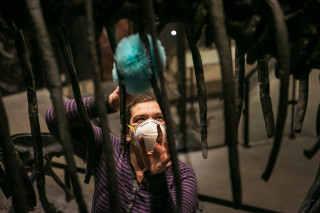
Emily Szalay carefully dusts in between some dino ribs. Photo by Mark Johnson. © NHMU.
I looked at the dinos as they prepped and noticed a little dust, but you really had to be examining them closely. How much needed to be done?
Thomas handed up a wet/dry vac with the hose plugged into the exhaust port. Leonard flipped it on, leaned out towards the skulls and blew a cloud of dust bunnies from the closest skull that immediately rose about 25 feet in diameter. Looking oddly like a good snowfall, it showed just how much had accumulated in a few years.
The team had assembled an impressive array of blowing and dusting tools, including a leaf blower, pressurized air gun, and several feather dusters on various lengths of poles. The goal was to blow or dust off all of the dino displays over four or five days and come back through at the end to sweep up all of the accumulated dust on the floors.
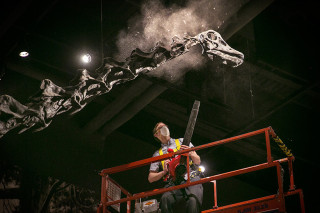
Geoffrey Leonard uses a leaf blower to knock some serious dust off of our Barosaurus. Photo by Mark Johnson. © NHMU.
While they did employ some powerful tools, the team was very focused on keeping the exhibits safe and secure. They are the ones who built the exhibits, after all, and the ones who have to periodically repair them when an overly enthusiastic visitor or some other disturbance comes in contact with them.
“Some of the dinosaurs are really fragile – look at the tiny spikes along the spine here,” explains Thomas, pointing to the chevrons of a Marshosaurus. “It’s easy to break things like that with a duster – you just have to be mega, mega careful. That’s our biggest concern: to not break anything.”
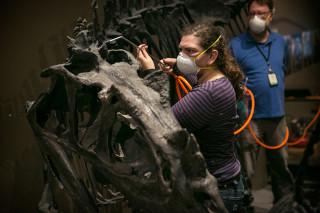
Emily Szalay does some detail dusting with pressurized air while Bill Thomas assists, ensuring the hoses stay clear of getting entangled in the skeleton. Photo by Mark Johnson. © NHMU.
So, as Thomas blew pressurized air over the entire length of a juvenile Allosaurus whose permanent pose had it balancing on one foot, Szalay held the head and spine in place. Likewise, when Szalay went over each of the vertebrae and the nooks and crannies in between with a turquoise feather duster, Black and Thomas steadied the beast to keep it from breaking its mount.
Gazing around, there was a lot of ground, or more precisely, air to cover. Each of the small Archaeopteryx skeletons was suspended on a cable caked with dust from the 35-foot ceiling. The head of our giant Barosaurus also rose about 30 feet off the ground, and it needed the same treatment. They were all on the list. Most impressively to me (who hates cleaning), the exhibits team approached the task good naturedly, in an unhurried, orderly fashion.
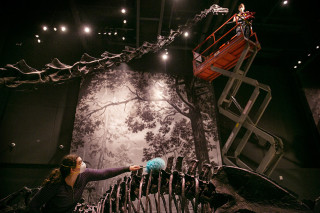
The exhibits team covers a lot of space in the Past Worlds Gallery to make sure it's as clean as it can be. Photo by Mark Johnson.
© NHMU.
No complaining? Well, that’s a technique I’ll have to replicate at home – seems to make the work go more smoothly.
As I left them with their leaf blowers bleating, their pressurized air tanks humming, and mechanical lift straining further upward, I knew the dinosaurs were in the best hands. I think we can all appreciate the thorough and careful job the NHMU exhibits team has done to make all of our galleries as beautiful as they can be.
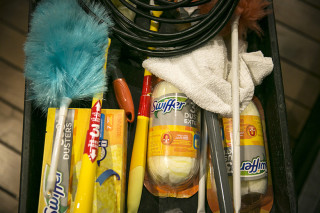
The more delicate tools used by the exhibits team when cleaning the Past Worlds Gallery. Photo by Mark Johnson.
© NHMU.
Michael Mozdy is a Digital Science Writer for The Natural History Museum of Utah, a part of the University of Utah in Salt Lake City. Our mission is to illuminate the natural world and the place of humans within it. In addition to housing outstanding exhibits for the public, NHMU is a research museum. Learn more.
